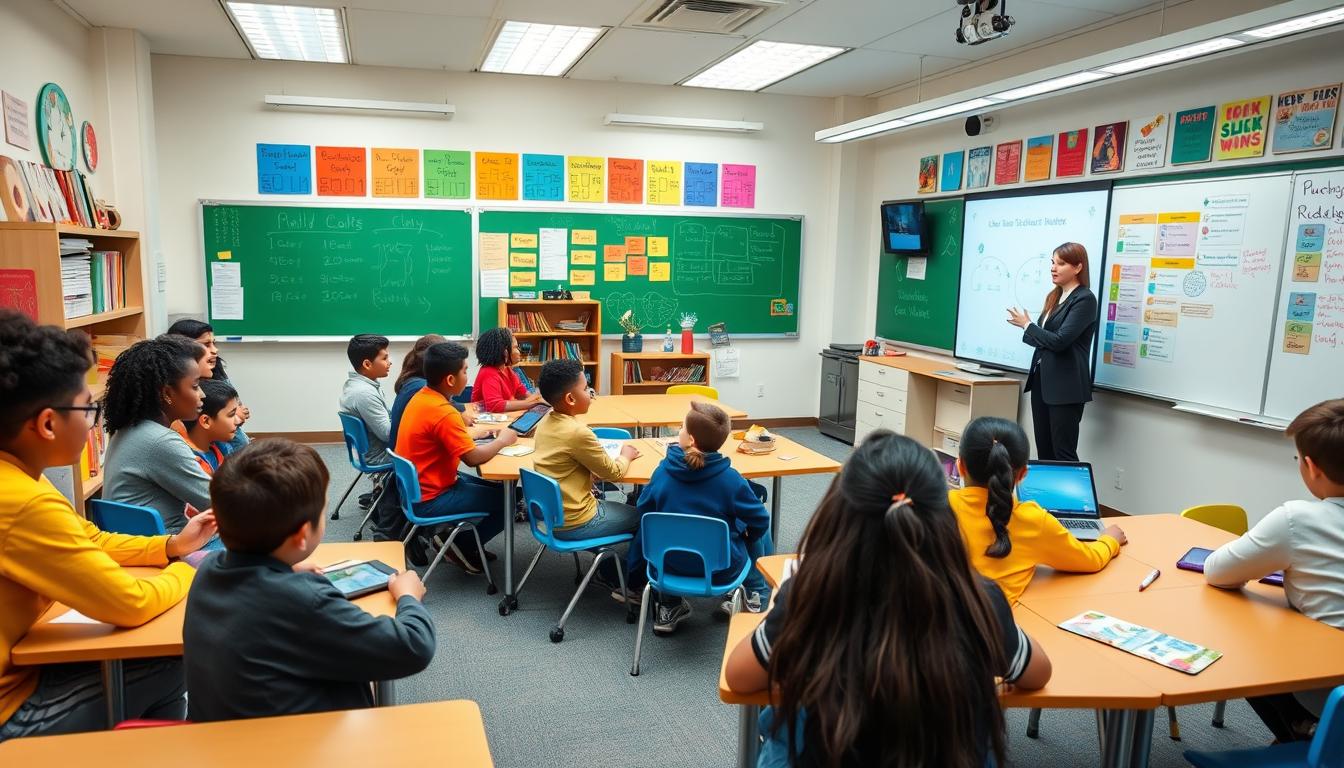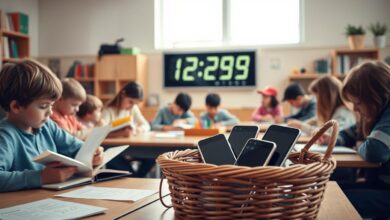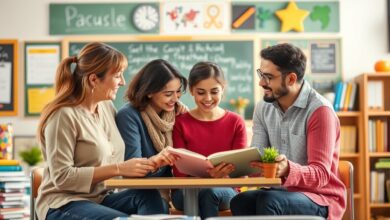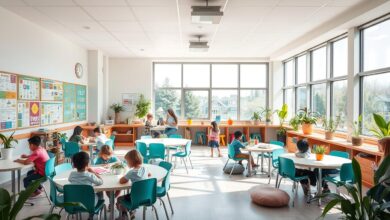Effective Classroom Management: Handling Disruptive Students

Table of Contents
I face significant challenges in classroom management every day. Disruptive behavior negatively impacts the educational process. Therefore, I started looking for solutions to create a better learning environment.
Classroom management requires special skills and studying student behavior. In this article, I’ll present some useful strategies for teachers. These strategies help address behavioral challenges constructively.
Our goal is to transform the classroom into a place students are proud of. Every student should feel respected and valued.
Understanding Disruptive Student Behavior and its Causes
Understanding the causes of disruptive behavior is very important. It helps solve problems in the classroom. Every student’s behavior needs careful interpretation.
Psychological Factors Influencing Student Behavior
Psychological factors play a significant role in student behavior. Disruptiveness can result from psychological issues such as:
- Low self-esteem
- Feelings of anxiety and stress
- A need for attention and validation
- Emotional communication difficulties
Impact of the Home Environment on School Behavior
The home environment has a major impact on a student’s personality. An unstable family may lead a student to seek alternative ways of expression at school.
| Home Environment Factors | Impact on Behavior |
|---|---|
| Lack of emotional care | Increased likelihood of aggressive behavior |
| Family breakdown | Weak self-regulation |
| Lack of communication | Seeking attention negatively |
The Role of Academic Challenges in Disruptiveness
Academic challenges significantly impact behavior. When a student faces learning difficulties, they may resort to disruptive behavior to express their frustration.
“Academic failure is not the end, but an opportunity for development and change.”
It’s important to understand that every disruptive student carries a unique story that deserves attention and understanding.
Effective Classroom Management Strategies

Classroom management is extremely important for teachers. I will provide you with some key methods for behavior control. I’ll also explain how to create a positive learning environment.
There are essential points in effective teaching strategies:
- Establishing clear and specific rules from the beginning of the school year
- Consistent application of rules to all students
- Using calm and confident body language
- Focusing on positive reinforcement
For effective classroom management, communication skills are important. Students should feel respected and cared for. It’s important to build positive relationships with them.
The primary goal of classroom management is to create a stimulating and safe learning environment for everyone.
It’s also important to develop flexibility in handling different situations. Each classroom has its unique characteristics. It’s necessary to adapt to the different needs of students in behavior management strategies.
Building Positive Relationships with Students
Positive relationships with students are fundamental to educational success. Every student possesses unique potential that needs to be discovered and encouraged.
The Importance of Effective Communication
Effective communication builds trust and understanding between teacher and student. I continue to develop my skills to communicate in a way that respects students’ feelings.
- Actively listening to students
- Understanding their emotional and academic needs
- Expressing genuine interest
Techniques for Earning Student Trust
I focus on building student trust through honesty and transparency. I make sure to keep promises and show full respect to every student.
| Technique | Goal |
|---|---|
| Keeping promises | Enhancing reliability |
| Individual attention | Understanding personal needs |
| Continuous support | Encouraging personal growth |
Creating an Atmosphere of Mutual Respect
I aim to create a classroom environment characterized by mutual respect. I believe that respect is built through fair treatment of all students.
“Mutual respect is a bridge connecting the teacher and the student.”
By using these strategies, I can build strong relationships. These relationships help improve the learning environment and reduce disruptive behavior.
Applying Classroom Rules Fairly
Applying classroom rules fairly is a major challenge for teachers. Fair application helps create a positive learning environment. This environment helps students grow and learn.
When setting classroom rules, it’s important to consider several points:
- Formulating clear and simple rules
- Involving students in setting the rules
- Explaining the importance of each rule
Positive discipline relies on understanding student behavior. It’s essential to focus on understanding the reasons behind a student’s behavior and guiding it constructively.
“Fairness is not about treating everyone the same, but about treating each student according to their specific needs.”
It’s also important to consider individual differences when applying rules. Each student has their own circumstances and personality. They should be handled flexibly while maintaining the essence of the rules.
Strategies for fair rule application include:
- Direct communication with the student
- Using positive language
- Focusing on the behavior, not the person
- Providing opportunities for correction
Ultimately, the goal is to create a respectful and organized classroom environment. This environment helps students learn and grow.
Using Positive Reinforcement and Rewards

Positive reinforcement plays a significant role in motivating students. It helps encourage good behavior in the classroom. Motivation strategies are important for creating a positive learning environment.
Appropriate Types of Rewards
There are many educational rewards to motivate students:
- Moral rewards such as praise and encouragement
- Motivational certificates and medals
- Leadership and responsibility opportunities in the classroom
- Extra points in evaluations
Appropriate Timing of Reinforcement
The timing of reinforcement is very important. Reinforcement should be provided:
- Immediately upon observing good behavior
- Proportionally to the achievement
- In a way that maintains student motivation
It’s important to mention that the goal of reinforcement is to encourage students to continue their effort and excellence, not just for material reward.
Organizing a Learning-Conducive Classroom Environment
I recognize the importance of creating a learning-conducive classroom environment. It helps students focus and reduces disruptive behavior. Classroom organization plays a crucial role in the success of the educational process.
When designing a positive learning atmosphere, I focus on several key elements:
- Arranging seating to allow for interaction and communication
- Providing dedicated spaces for individual and group work
- Using calming colors that help with relaxation
- Organizing educational materials in a structured and easily accessible way
Involving students in maintaining the cleanliness and organization of the classroom enhances their sense of responsibility and belonging.
| Elements of a Stimulating Classroom Environment | Impact on Learning |
|---|---|
| Appropriate lighting | Improved focus and mood |
| Good ventilation | Increased mental activity |
| Spatial organization | Reduced distraction and improved productivity |
“A classroom is not just a place; it’s a world of educational opportunities.”
I always strive to create a stimulating classroom environment. It encourages students to learn and excel. It contributes positively to building their personalities.
Integrating Interactive Activities into Lessons
Active learning makes you more engaged in studying. It creates a lively and enjoyable study environment.
Purposeful Educational Games
Educational games make studying fun. Here are some useful games for all school subjects:
- Science quiz games
- Educational digital games
- Cooperative competitive games
Collaborative Group Projects
Group projects enhance teamwork skills. Here are some useful examples:
| Project Type | Educational Goal |
|---|---|
| Joint research project | Developing research and analytical skills |
| Collaborative art project | Developing creativity and communication skills |
| Educational role-playing simulations | Understanding complex concepts interactively |
Through these activities, I aim to create an active learning environment. It helps encourage students to participate and learn with enjoyment.
Handling Emergency Situations in the Classroom
In the world of teaching, classroom crisis management is an essential skill. Every teacher must master it. I approach emergency situations calmly and wisely. I use rapid intervention to prevent disruptive behavior.
When facing a difficult situation, I follow specific steps to resolve conflicts:
- Maintaining calm and controlling emotions
- Actively listening to all parties
- Objectively identifying the core of the problem
- Proposing constructive solutions
I use specific strategies to deal with different situations:
| Type of Situation | Strategy |
|---|---|
| Verbal altercations | Separating parties and holding a dialogue session |
| Aggressive behavior | Immediate intervention and removing sources of tension |
| Non-compliance with rules | Clarifying consequences and applying fair penalties |
I recognize the importance of positive communication in conflict resolution. I always ensure to address problems in a way that preserves students’ dignity and fosters mutual learning.
“The goal of classroom crisis management is not suppression, but building a respectful and organized learning environment.”
In complex cases, I don’t hesitate to ask for help. I seek assistance from school administration or specialists to ensure student safety and comfort.
Effective Communication with Parents

Communicating with parents is very important for student success. The partnership between teachers and parents helps support students. It also improves the learning environment.
Mechanisms for Involving Families in the Educational Process
I offer several strategies to engage parents in the educational process:
- Holding regular meetings with parents
- Sending emails and using apps for direct communication
- Organizing educational workshops for families
- Involving parents in school activities
Behavior Monitoring Reports
Behavior reports are important for transparent communication with parents. I make sure to design reports that are:
- Clear and objective
- Focused on positive development
- Offering constructive suggestions
- Highlighting challenges and proposed solutions
“The partnership between school and family is key to student success.”
I recognize the importance of building a cooperative relationship based on trust and respect. I always strive to create open communication channels. These channels help support students and improve their behavior.
Conclusion
Improving student behavior requires a deep understanding of challenges. Effective strategies rely on building strong relationships with students. There must also be a focus on positive communication and fruitful interaction.
Through my experience, I’ve realized the importance of a positive learning environment. It relies not on suppression but on support and understanding. We need flexible methods that consider differences and are based on respect and motivation.
I urge teachers to focus on preventative rather than punitive strategies. Communication and classroom interaction skills must be developed. Success comes with patience, perseverance, and belief in every student’s abilities.
Creating a stimulating and respectful learning environment is our goal. This requires continuous cooperation among teachers, students, and parents.
Frequently Asked Questions (FAQ): Dealing with Disruptive Students
How can I deal with a disruptive student without shouting or harsh punishment?
Use positive communication strategies. Start by speaking calmly and firmly. Use clear language. Explain to the student why their behavior is unacceptable. Focus on correcting the behavior, not punishment. Understand the reasons behind their behavior and address them constructively.
What are the best ways to build a good relationship with disruptive students?
Listen actively. Show genuine interest in their lives. Learn about their personal interests and challenges. Dedicate time to talk with them individually. Provide continuous support. Focus on their strengths.
How can classroom rules be applied fairly?
Set clear and understandable rules. Involve students in setting them. Apply these rules consistently to everyone. Consider individual differences. Explain the reason for each rule. Link rules to values such as respect and cooperation.
What is the importance of positive reinforcement in improving student behavior?
Positive reinforcement plays a pivotal role. Reward and encourage good performance, rather than just reprimanding bad behavior. This builds self-confidence and develops internal motivation for improvement.
How do I handle emergency situations in the classroom?
Maintain calm and control. Intervene quickly and firmly at the start of heated situations. Use calm and clear language. Separate the person from the behavior. Work to resolve the conflict constructively.



